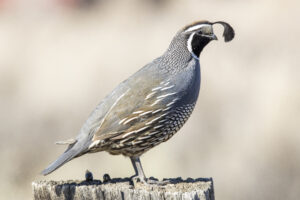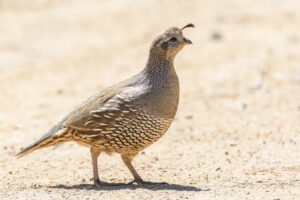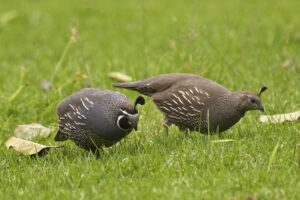California Quail: The Complete Homestead Guide
Callipepla californica – The Golden State’s Iconic Gamebird

Quick Reference Stats
- Egg Production: 80-120 eggs per year
- Maturity: 20-24 weeks
- Adult Weight: 5-7 oz
- Feed Conversion: 4:1
- Space Required: 3-5 sq ft per bird
- Lifespan: 4-6 years
- Flight Capability: Strong fliers, excellent escape artists
Introduction
The California quail stands as one of North America’s most recognizable gamebirds, distinguished by its distinctive teardrop-shaped head plume and intricate plumage patterns. As the official state bird of California, these birds represent both natural beauty and practical homestead potential. Their striking appearance, hardiness, and moderate production capabilities make them excellent choices for ornamental purposes, specialty meat production, and conservation-minded breeding programs.
California quail possess unique social behaviors and environmental adaptations that set them apart from other quail species. Their complex covey structures, seasonal migration patterns, and distinctive calls create management challenges and rewards that appeal to experienced gamebird enthusiasts and homesteaders seeking something beyond conventional poultry.
Breed Overview

Physical Characteristics
Male Characteristics:
- Head Plume: Distinctive forward-curving black plume
- Coloring: Rich brown back, gray-blue chest, white-striped face
- Size: 5-6 ounces, slightly smaller than females
- Features: Bold white chinstrap and forehead markings
Female Characteristics:
- Head Plume: Smaller, less prominent plume
- Coloring: More subdued brown and buff tones
- Size: 6-7 ounces, larger and heavier than males
- Features: Less distinct facial markings, better camouflage
Chick Development:
- Hatching: Precocial, mobile immediately after hatching
- Juvenile Plumage: Brown and buff striped pattern
- Adult Plumage: Develops over 16-20 weeks
- Sex Determination: Difficult until mature plumage appears
Subspecies and Geographic Variations
Recognized Subspecies:
- California Quail (C. c. californica): Coastal and valley populations
- Valley Quail (C. c. vallicola): Interior valley and foothill birds
- Desert Quail (C. c. achrustera): Southern California desert populations
- San Lucas Quail (C. c. plumbea): Baja California peninsula birds
Captive-Bred Varieties:
- Standard: Wild-type coloration
- Blonde: Light tan and cream mutations
- Silver: Reduced pigmentation varieties
- Jumbo: Selected for larger size (6-8 oz)
Social Behavior and Covey Structure
Natural Social Patterns:
- Covey Size: 10-40 birds outside breeding season
- Family Units: Pair bonds during breeding season
- Hierarchy: Complex social ranking within coveys
- Communication: Variety of calls for different situations
Seasonal Behavior Changes:
- Fall/Winter: Large mixed coveys for protection
- Spring: Covey breakup for pair formation
- Summer: Family groups with chicks
- Migration: Local movements following food and water
Housing Requirements
Space and Facility Needs
Minimum Requirements:
- Floor Space: 3 square feet per bird minimum
- Recommended: 5-8 square feet per bird for optimal welfare
- Height: 8-10 feet minimum to accommodate flight
- Covey Housing: 15-30 birds per large flight pen
Flight Pen Design: California quail are strong fliers requiring specialized containment compared to other quail species.
Essential Features:
- Full Roof Coverage: Mesh or solid roofing to prevent escapes
- Soft Ceiling Material: Prevents injury from panic flights
- Multiple Escape Routes: Various flight paths within pen
- Visual Barriers: Solid panels to break line of sight
- Natural Cover: Shrubs, brush piles, and hiding spots
Specialized Housing Components
Shelter Structures:
- A-Frame Shelters: Multiple units throughout pen
- Brush Piles: Natural or constructed hiding areas
- Roosting Areas: Elevated perches 2-3 feet high
- Nesting Boxes: Ground-level, hidden locations
Environmental Features:
- Dust Bath Areas: Sand or fine dirt sections
- Water Features: Multiple shallow water sources
- Feeding Stations: Scattered locations to reduce competition
- Windbreaks: Protection from prevailing winds
Predator Protection
Primary Threats:
- Aerial Predators: Hawks, owls, ravens, crows
- Ground Predators: Foxes, raccoons, domestic cats, snakes
- Burrowing Predators: Weasels, rats, ground squirrels
- Domestic Animals: Dogs, cats, free-ranging chickens
Protection Methods:
- Overhead Netting: 1-inch mesh or smaller
- Underground Barriers: 12-inch buried apron of hardware cloth
- Double Fencing: Inner and outer fence systems
- Motion Detection: Automated deterrent systems
Environmental Adaptations

Climate Requirements
Temperature Tolerance:
- Optimal Range: 40-85°F
- Cold Tolerance: Down to 10°F with shelter
- Heat Tolerance: Up to 100°F with shade and water
- Seasonal Adaptation: Natural acclimatization patterns
Humidity Preferences:
- Optimal: 30-60% relative humidity
- Adaptation: Tolerates both dry and humid conditions
- Desert Adaptation: Water conservation abilities
- Coastal Adaptation: Fog and moisture tolerance
Seasonal Management
Spring Management (March-May):
- Breeding Preparation: Increase protein, provide nesting areas
- Facility Maintenance: Repair winter damage, deep cleaning
- Health Monitoring: Parasite prevention, vaccination updates
- Pair Formation: Separate breeding groups from coveys
Summer Management (June-August):
- Heat Stress Prevention: Shade, ventilation, cool water
- Chick Rearing: Brooding areas, predator protection
- Peak Production: Egg collection, incubation management
- Water Management: Multiple sources, constant availability
Fall Management (September-November):
- Covey Formation: Allow natural grouping behaviors
- Winter Preparation: Shelter improvements, feed storage
- Processing Season: Harvest surplus birds
- Breeding Stock Selection: Choose next year’s breeders
Winter Management (December-February):
- Cold Weather Care: Windbreak maintenance, shelter access
- Nutrition Support: Higher calorie feeds, warm water
- Reduced Activity: Minimal disturbance during harsh weather
- Planning Phase: Prepare for next breeding season
Feeding and Nutrition
Nutritional Requirements by Life Stage
Chick Nutrition (0-8 weeks):
- Protein: 28-30%
- Fat: 4-5%
- Fiber: Maximum 3%
- Feed Form: Fine crumbles or mash
Growing Period (8-20 weeks):
- Protein: 20-24%
- Fat: 5-6%
- Fiber: 5-8%
- Feed Form: Small pellets or crumbles
Adult Maintenance (20+ weeks):
- Protein: 16-20%
- Fat: 4-6%
- Fiber: 8-12%
- Feed Form: Pellets or mixed grain
Breeding Season:
- Protein: 22-26%
- Fat: 6-8%
- Additional: Calcium supplement, vitamins
- Timing: 4-6 weeks before egg laying begins
Natural Foraging Behavior
Preferred Foods:
- Seeds: Grass seeds, forb seeds, acorns
- Green Matter: Shoots, leaves, flowers
- Insects: Beetles, ants, caterpillars, larvae
- Seasonal Foods: Berries, nuts, cactus fruits
Foraging Patterns:
- Morning Activity: Primary feeding period
- Midday Rest: Shelter seeking during heat
- Evening Activity: Secondary feeding period
- Seasonal Variation: Diet changes with food availability
Commercial Feeding Programs
Feed Selection:
- Gamebird Feed: Specifically formulated, best option
- Turkey Feed: Acceptable substitute with modifications
- Waterfowl Feed: Good for adults, adjust protein
- Custom Blends: Mixed feeds for specific needs
Feeding Schedule:
- Daily Amount: 1.5-2.5 ounces per adult bird
- Feeding Times: Early morning and late afternoon
- Method: Scatter feeding to encourage natural behavior
- Supplement: Grit, oyster shell, fresh greens
Water Requirements:
- Daily Consumption: 2-4 ounces per bird
- Quality: Clean, fresh water changed daily
- Availability: Multiple water sources throughout pen
- Winter: Heated waterers to prevent freezing
Breeding and Reproduction
Breeding Biology
Mating System:
- Monogamous: Generally one male per female
- Pair Bonds: Strong seasonal pair bonds
- Courtship: Elaborate male displays and calling
- Territory: Males defend breeding territories
Breeding Season:
- Natural Season: April through August
- Peak Period: May through July
- Photoperiod: Triggered by increasing daylight
- Weather Factors: Rainfall and temperature influence timing
Nesting Behavior
Nest Site Selection:
- Ground Nests: Hidden in vegetation or under cover
- Location Preferences: Near shelter, good visibility
- Nest Construction: Simple scrape lined with vegetation
- Nest Concealment: Well-hidden from predators
Egg Laying and Incubation:
- Clutch Size: 10-17 eggs (average 12-14)
- Laying Pattern: One egg per day until clutch complete
- Incubation Period: 21-23 days
- Incubation Behavior: Female incubates, male guards
Artificial Incubation
Incubator Settings:
- Temperature: 99.5°F
- Humidity: 60% days 1-18, 70% days 19-23
- Turning: Every 2-4 hours until day 18
- Ventilation: Adequate air exchange
Hatch Management:
- Pip to Hatch: 24-36 hours
- Assistance: Generally not recommended
- Drying Period: 2-4 hours in incubator
- Transfer: Move to brooder when dry and active
Chick Rearing
Brooding Requirements:
- Starting Temperature: 95°F
- Temperature Reduction: 5°F per week
- Brooding Duration: 4-6 weeks
- Space: 0.5 square feet per chick initially
Critical Care Period:
- First 48 Hours: Monitor closely for feeding and drinking
- Feed: High-protein gamebird starter
- Water: Shallow containers to prevent drowning
- Heat: Consistent, adjustable heat source
Juvenile Development:
- Feather Development: Flight feathers at 2-3 weeks
- Independence: Gradual weaning at 6-8 weeks
- Adult Integration: Careful introduction to adult flock
- Sex Identification: Possible at 12-16 weeks
Health Management
Common Health Issues
Respiratory Diseases:
- Infectious Bronchitis: Viral respiratory infection
- Mycoplasma: Bacterial respiratory disease
- Aspergillosis: Fungal respiratory infection
- Prevention: Good ventilation, low stress, quarantine
Parasitic Infections:
- External Parasites: Mites, lice, ticks
- Internal Parasites: Roundworms, cecal worms, coccidia
- Gapeworms: Respiratory tract parasites
- Treatment: Regular monitoring, preventive programs
Nutritional Disorders:
- Leg Problems: Calcium/phosphorus imbalance
- Feather Issues: Protein or vitamin deficiencies
- Egg Problems: Shell quality issues, egg binding
- Growth Issues: Poor feed quality or disease
Behavioral Problems:
- Feather Picking: Overcrowding, nutritional deficiency
- Cannibalism: Stress, inadequate nutrition
- Escape Attempts: Inadequate housing, stress
- Aggression: Territorial disputes, breeding competition
Disease Prevention
Biosecurity Measures:
- Quarantine Protocol: 30-45 days for new birds
- Visitor Control: Limit access to bird areas
- Equipment Sanitation: Disinfect between uses
- Footbaths: Disinfectant stations at pen entrances
Vaccination Programs:
- Newcastle Disease: Recommended in most areas
- Fowl Pox: In mosquito-prevalent regions
- Infectious Bronchitis: Consult with veterinarian
- Timing: Follow manufacturer’s recommendations
Environmental Management:
- Sanitation: Regular cleaning of feeders and waterers
- Ventilation: Adequate air exchange without drafts
- Density: Avoid overcrowding stress
- Nutrition: Balanced, high-quality feeds
Health Monitoring
Daily Observations:
- Behavior: Normal activity patterns and social interaction
- Appetite: Feed and water consumption
- Respiratory: Clear breathing, no discharge
- Mobility: Normal movement and posture
Weekly Health Checks:
- Weight: Body condition assessment
- Feathers: Quality and coverage
- Eyes and Nostrils: Clear, no discharge
- Legs and Feet: Check for injuries or abnormalities
Record Keeping:
- Health Logs: Daily observations and treatments
- Production Records: Egg laying, hatch rates
- Mortality Tracking: Causes and prevention measures
- Vaccination Records: Dates and types administered
Production Management
Meat Production
Processing Considerations:
- Optimal Age: 20-24 weeks for best meat quality
- Live Weight: 5-7 ounces
- Dressed Weight: 3.5-5 ounces
- Meat Characteristics: Lean, flavorful, slightly gamey
Processing Requirements:
- Regulations: State and federal inspection requirements
- Licensing: Processing facility permits
- HACCP: Food safety protocols
- Labeling: Proper product identification
Market Preparation:
- Packaging: Vacuum sealed or wrapped
- Storage: Proper refrigeration or freezing
- Transportation: Temperature-controlled delivery
- Presentation: Professional packaging and labeling
Egg Production Management
Laying Performance:
- First Year: 60-80 eggs per female
- Peak Production: 80-120 eggs in second year
- Decline: Gradual reduction after third year
- Seasonal Pattern: Spring through fall peak
Collection and Handling:
- Frequency: Check nests twice daily
- Timing: Early morning and late afternoon
- Storage: Cool, humid conditions
- Handling: Gentle, minimal washing
Incubation Management:
- Egg Selection: Choose clean, properly shaped eggs
- Storage: No more than 7 days before incubation
- Fertility: Expect 70-85% fertility rate
- Hatch Rate: 60-75% of fertile eggs
Breeding Stock Management
Selection Criteria:
- Health: Disease-free, vigorous birds
- Conformation: Proper size and body type
- Production: Good egg laying or growth rates
- Temperament: Calm, non-aggressive behavior
Genetic Management:
- Bloodline Tracking: Maintain breeding records
- Inbreeding Avoidance: Introduce new genetics regularly
- Line Development: Focus on specific traits
- Culling Programs: Remove poor performers
Economic Analysis
Startup Investment
Initial Costs:
- Breeding Stock: $25-50 per breeding bird
- Housing: $25-50 per bird capacity
- Equipment: $200-500 total setup
- Feed and Supplies: $100-200 initial investment
Annual Operating Costs:
- Feed: $30-50 per bird annually
- Healthcare: $3-8 per bird
- Utilities: $100-300 total
- Maintenance: $150-400 annually
Revenue Streams
Breeding Stock Sales:
- Day-Old Chicks: $3-6 each
- Started Birds: $15-25 each
- Adult Breeders: $30-75 per pair
- Show Quality: $50-150 per bird
Meat Sales:
- Processed Birds: $15-25 per bird
- Live Birds: $10-18 per bird
- Specialty Markets: Premium pricing available
- Direct Sales: Higher margins than wholesale
Egg Sales:
- Hatching Eggs: $2-4 each
- Table Eggs: Limited market demand
- Specialty Uses: Restaurant and gourmet market
Value-Added Products:
- Feathers: Fly-tying and craft markets
- Educational Programs: Living history demonstrations
- Agritourism: Farm visits and educational tours
Market Development
Target Markets:
- Game Preserves: Flight-conditioned birds
- Collectors: Ornamental and breeding stock
- Restaurants: Specialty game meat
- Hobbyists: Small-scale breeding projects
- Conservation: Habitat restoration projects
Marketing Strategies:
- Online Presence: Website and social media
- Trade Shows: Poultry and game bird exhibitions
- Networking: Connections with other breeders
- Quality Reputation: Consistent, healthy stock
Legal and Regulatory Framework
Federal Regulations
Migratory Bird Treaty Act:
- Protection Status: California quail are protected
- Captive-Bred Exemption: Legal for domestically raised birds
- Documentation: Required for sales and transport
- Penalties: Severe for violations
USDA Requirements:
- Pullorum Testing: Required for breeding flocks
- Health Certificates: Interstate transport requirements
- Processing Inspection: Federal or state inspection required
- Record Keeping: Detailed production records
State Regulations
California Specific:
- Game Breeder License: Required for commercial breeding
- Facility Standards: Minimum requirements for housing
- Health Testing: Regular disease testing required
- Sale Restrictions: Regulations on live bird sales
Other States:
- Import Requirements: Health certificates and testing
- Licensing: Game breeder or exotic bird permits
- Inspection: Annual facility inspections
- Release Prohibitions: Cannot release into wild
Local Considerations
Zoning Requirements:
- Agricultural Zoning: Usually required for commercial operations
- Urban Restrictions: May be prohibited in city limits
- Special Permits: Conditional use permits may be needed
- Noise Ordinances: Male calling may be restricted
Insurance and Liability:
- Property Insurance: Coverage for facilities and stock
- Liability Insurance: Protection against accidents
- Product Liability: Coverage for food products
- Business License: Local business operation permits
Conservation and Educational Value
Conservation Significance
Habitat Preservation:
- Native Range: Western North America
- Habitat Loss: Urban development pressure
- Captive Breeding: Genetic reservoir maintenance
- Reintroduction: Potential for habitat restoration
Genetic Diversity:
- Subspecies Preservation: Maintaining distinct populations
- Breeding Programs: Coordinated conservation efforts
- Research Value: Studies of behavior and ecology
- Education: Public awareness of native species
Educational Applications
Living History:
- Native Culture: Indigenous peoples’ relationships with quail
- Pioneer Era: Role in frontier survival
- Agricultural History: Traditional gamebird management
- Conservation Story: Modern habitat challenges
Scientific Education:
- Behavior Studies: Social structure research
- Ecology Lessons: Predator-prey relationships
- Life Cycle: Reproduction and development
- Adaptation: Environmental specializations
Advanced Management Topics
Behavioral Enrichment
Natural Behaviors:
- Foraging: Scatter feeding and hidden food
- Dust Bathing: Sand and fine soil areas
- Roosting: Elevated perching opportunities
- Social Interaction: Appropriate group sizes
Environmental Complexity:
- Varied Terrain: Hills, valleys, and different levels
- Vegetation: Live plants and brush piles
- Water Features: Multiple water sources and types
- Hiding Places: Numerous retreat options
Specialized Breeding Programs
Color Development:
- Mutation Breeding: Developing new color varieties
- Line Breeding: Concentrating desired traits
- Outcrossing: Maintaining genetic diversity
- Record Keeping: Detailed genetic tracking
Performance Selection:
- Egg Production: Selecting for laying ability
- Growth Rate: Faster-growing strains
- Hardiness: Cold and heat tolerance
- Flight Ability: Maintaining natural capabilities
Research and Documentation
Production Records:
- Daily Observations: Behavior and health notes
- Production Data: Eggs, weights, feed consumption
- Breeding Results: Fertility, hatch rates, survival
- Environmental Conditions: Temperature, weather effects
Photographic Documentation:
- Development Stages: Chick to adult progression
- Breeding Behaviors: Courtship and nesting
- Facility Design: Housing and equipment examples
- Problem Documentation: Health issues and solutions
Conclusion
California quail represent a unique opportunity for homesteaders and gamebird enthusiasts to work with one of North America’s most beautiful and iconic species. Their distinctive appearance, moderate production capabilities, and conservation value make them excellent choices for specialized breeding programs, ornamental collections, and sustainable meat production.
Success with California quail requires understanding their complex social behaviors, specialized housing needs, and unique environmental requirements. Their strong flight capabilities and intricate covey structures demand more sophisticated management than domestic poultry, but the rewards include working with birds that maintain their wild instincts and natural beauty.
The combination of ornamental value, moderate production potential, and conservation significance creates multiple opportunities for California quail enterprises. Whether focusing on breeding stock sales, specialty meat production, or conservation breeding programs, these birds offer homesteaders a chance to work with truly special native wildlife while potentially generating income from their natural beauty and heritage value.
The key to successful California quail management lies in respecting their wild nature while providing the security and nutrition they need to thrive in captivity. Their status as California’s state bird and their role in western ecosystems adds significance beyond simple production, making them ideal for homesteaders who value both practical benefits and conservation contributions.


